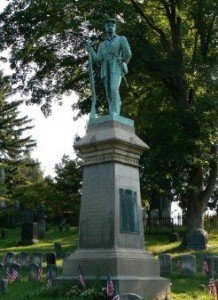 This granite and bronze monument in the Village of Sleepy Hollow, is located near southwestern corner of the Sleepy Hollow Cemetery and was dedicated on May 30, 1890. by the local GAR post. Inscriptions on the front (west) face include a Latin dedication, along with “Our Union Soldiers” and the following poem: “While Freedom’s name is understood, they shall delight the wise and good- They dared to set their country free and gave her laws equality 1861-1865.”
This granite and bronze monument in the Village of Sleepy Hollow, is located near southwestern corner of the Sleepy Hollow Cemetery and was dedicated on May 30, 1890. by the local GAR post. Inscriptions on the front (west) face include a Latin dedication, along with “Our Union Soldiers” and the following poem: “While Freedom’s name is understood, they shall delight the wise and good- They dared to set their country free and gave her laws equality 1861-1865.”
The monument’s south, east and north faces feature bronze plaques honoring some 240 local veterans. The references to Greenburgh and Mount Pleasant reflect the fact that the Village of Sleepy Hollow lies within Mount Pleasant, which is just north of Greenburgh. The monument is surrounded by a plot containing graves of Civil War veterans. The names of soldiers killed in action are engraved into the monument’s base- those who served are listed on tablets mounted to the base. The work was made in the New York foundry of the Henry-Bonnard Bronze Company.
The infantry soldier was sculpted by Johnson Marchant Mundy, who was legally blind when he created the figure. Mundy- was born in New Brunswick, N.J., in May, 1833- died in Geneva, N. Y., Aug. 16, 1897. Among his other works are a marble bust of Frederick Douglass, which occupies a conspicuous place in the capitol at Washington, D. C- a marble bust of Bishop Delancey, which has been placed in the new Episcopal church at Geneva, NY, one of the late Dr. Hale, dean of Hobart College. and one of Washington Irving in Tarrytown, NY.
Civil War Cannon Monument, Somers, NY
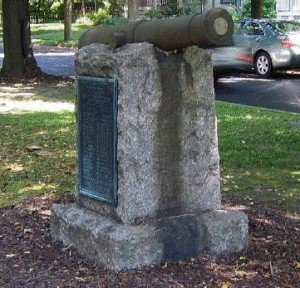 This memorial honors those from the Village of Somers, New York and vicinity “who enlisted to serve during the Civil War,” under the leadership of captains James McKeel and John W. Sweetman. The memorialized were members of company A, 4th New York Volunteers, Heavy Artillery. Appropriately, the form of the remembrance is a civil war cannon, positioned atop granite rectangular base with pedestal. On the opposite sides of the stone there is bronze plaque bearing the names. The East plaque says: “In Memoriam Capt. James Mckeel, Capt. John W. Sweetman And Members of Co. A 4th N.Y. Vol. Heavy Arty Who Enlisted From Katonah, NY to Serve During The Civil War of 1861 1865 James C. Bogan, Franklin Dingee, Oscar L. Dearborn, Leonidas E. Gallahue, Edgar Hitt, Rufus Hitt, Patrick Hughes. Robert A. Reynolds, Leonard H. Secor, Clark See, Harrison Totten, Stark V. Totten and Albert Tucker.”
This memorial honors those from the Village of Somers, New York and vicinity “who enlisted to serve during the Civil War,” under the leadership of captains James McKeel and John W. Sweetman. The memorialized were members of company A, 4th New York Volunteers, Heavy Artillery. Appropriately, the form of the remembrance is a civil war cannon, positioned atop granite rectangular base with pedestal. On the opposite sides of the stone there is bronze plaque bearing the names. The East plaque says: “In Memoriam Capt. James Mckeel, Capt. John W. Sweetman And Members of Co. A 4th N.Y. Vol. Heavy Arty Who Enlisted From Katonah, NY to Serve During The Civil War of 1861 1865 James C. Bogan, Franklin Dingee, Oscar L. Dearborn, Leonidas E. Gallahue, Edgar Hitt, Rufus Hitt, Patrick Hughes. Robert A. Reynolds, Leonard H. Secor, Clark See, Harrison Totten, Stark V. Totten and Albert Tucker.”
The memorial was later rededicated, again on Memorial Day, in 1933, at which time a second plaque was attached to the opposite side of the stone base – on this occasion honoring friends (Judge and Bedford Supervisor William H. Robertson) and comrades (the earlier-mentioned Private J.T. Lockwood and Captain James McKeel among them) who were charter members of this plaque’s sponsoring organization, McKeel Post No. 120, State of New York Grand Army of the Republic. It is situated among the trees on the Bedford Road divide near Parkway. The work was originally sponsored by one of the Company A volunteers, Private Jeremiah T. Lockwood, and dedicated May 30, 1914.
The Lincoln Exedra. Peekskill, NY
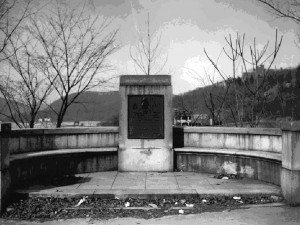 The Lincoln Exedra was created to commemorate President Lincoln’s stop in Peekskill, NY in 1861 on his journey to his inauguration in Washington, DC. Therefore, it is not a Civil War Monument as such and its inclusion here is based solely on fact of its connection with the president who led the Union during the War and of whom it could rightly be said died for leading the fight to preserve it. The monument is located on South Street in Peekskill and provides a direct line for viewing the original train depot (now the Lincoln Depot) below to the West. The land was donated by John Smith Jr., a veteran of the Civil War and a President of the Lincoln Society from 1917-1918. It was designed by Peekskill architect, Gilbert H. Anderson and his artist brother, Victor C. Anderson. Antonio S. Renza built the structure with granite furnished by the Grenci &- Ellis quarry.
The Lincoln Exedra was created to commemorate President Lincoln’s stop in Peekskill, NY in 1861 on his journey to his inauguration in Washington, DC. Therefore, it is not a Civil War Monument as such and its inclusion here is based solely on fact of its connection with the president who led the Union during the War and of whom it could rightly be said died for leading the fight to preserve it. The monument is located on South Street in Peekskill and provides a direct line for viewing the original train depot (now the Lincoln Depot) below to the West. The land was donated by John Smith Jr., a veteran of the Civil War and a President of the Lincoln Society from 1917-1918. It was designed by Peekskill architect, Gilbert H. Anderson and his artist brother, Victor C. Anderson. Antonio S. Renza built the structure with granite furnished by the Grenci &- Ellis quarry.
The center of the Exedra contains a bronze portrait tablet of Lincoln that was created at the Tiffany Studios in New York City. The Lincoln Exedra, constructed in 1925 at a cost of $6,100, was paid for by donations raised by the Lincoln Society under then-society President Chester A. Smith. The land for the monument was donated by Civil War veteran John Smith Jr., and was designed by Peekskill Architect Gilbert H. Anderson based on a painting by his brother Victor. The foundation was built by resident Antonio S. Renza with marble donated by Grenci and Ellis from their Mohegan quarry. The bronze bust of Lincoln was created by Tiffany Studios of New York.
Soldiers’ Monument, Port Chester, N.Y.
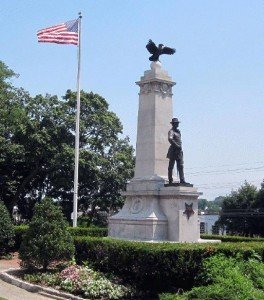 Port Chester, N.Y.’s 1900 Civil War Monument is located at a triangular park at the intersection of the Boston Post Road (Route 1) and Pearl Street. It features a bronze statue of a Civil War officer, Lt. Col. Nelson B. Bartram, a Port Chester resident who commanded the 17th New York Infantry Regiment before commanding the 20th Regiment of the United States Colored Troops. Bartram’s units saw action at Antietam as well as both Battles of Bull Run and the New Orleans region. It also has an eagle atop an ornate granite obelisk. The eagle is a 2008 replacement for the original, stolen earlier.
Port Chester, N.Y.’s 1900 Civil War Monument is located at a triangular park at the intersection of the Boston Post Road (Route 1) and Pearl Street. It features a bronze statue of a Civil War officer, Lt. Col. Nelson B. Bartram, a Port Chester resident who commanded the 17th New York Infantry Regiment before commanding the 20th Regiment of the United States Colored Troops. Bartram’s units saw action at Antietam as well as both Battles of Bull Run and the New Orleans region. It also has an eagle atop an ornate granite obelisk. The eagle is a 2008 replacement for the original, stolen earlier.
The front face also features a bronze representation of a Grand Army of the Republic medallion. A plaque on the southeast face of the monument’s basereads: “To the Union Defence Committee of the Town of Rye who pledged their honor to sustain the government and ensure a successful outcome of the war of the rebellion.”Ornate scrollwork near the top of the monument features the U.S. seal, and the other faces are decorated with stone wreaths that surround Union Army corps symbols as follow: On the west face is a carving of a three leaf clover, the badge design of the Union Army 2nd Corps, Army of the Potomac. On the north face is a carving of a Maltese cross, the badge design of the Union Army 5th Corps, Army of the Potomac. On the east face is an carving of a crescent moon, the badge design of the Union Army 11th Corps, Army of the Potomac. There is a stone platform base with a bronze GAR star.
John Massey Rhind designed the monument. He also designed four monuments on the Gettysburg battlefield and numerous other public monuments and statues. Rhind’s statue of Colonel Bartram was cast three years before the monument’s formal dedication. The delay was caused by objections from some local veterans that the monument was honoring an officer, instead of an enlisted man. They also objected that the bronze cast emblem of the GAR was not the official one. Nonetheless, on September 26, 1900 over 2000 Civil War, Spanish American War veterans and
fire departments, other civic societies and a chorus of 200 children paraded in the town of Port Chester, NY for the dedication. The statue was cast at the Abendroth Brothers Foundry a manufacturer of iron stoves, fancy yard pieces, hollow ware, planters, boilers, etc. in Port Chester.
The Confederate Monument in Hastings, NY
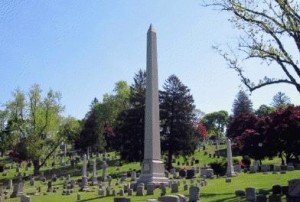 In the wake of the Civil War which devastated the South, many Southerners moved north to improve their circumstances. Some became quite successful in both business and even politics. However, they remained proud of their Southern roots and formed affinity groups such as the
In the wake of the Civil War which devastated the South, many Southerners moved north to improve their circumstances. Some became quite successful in both business and even politics. However, they remained proud of their Southern roots and formed affinity groups such as the
Southern Society and the United Confederate Veterans (UCV) to soothe the longings for home and to provide relief for needy Southerners in the North. In the 1890s, the New York Camp of the UCV purchased a 400 square foot plot in Mount Hope Cemetery in Hastings, NY in which to bury its members. Among the most prominent of these graves is one that has the remains of General Edwin Selvedge a veteran of 30 battles and the last surviving veteran of the organization. Ironically, he was fated to die in a taxicab accident in Brooklyn, NY in 1930. Another interesting grave is that of Eugene H. Levy, a veteran of Donaldson’s Artillery. It displays the Star of David.
Hundreds of people attended the dedication of the monument and burial ground on May 22, 1897.The New York times reported that a parade headed by composer Victor Herbert’s 22nd Regiment Band, New York National Guard was in the lead. The band played a medley of Union and Confederate tunes and they were followed by various units of the GAR from New York, Brooklyn and Connecticut. Behind them came 100 members of the Confederate Veterans and several other Southern organizations as well as numerous local officials. The dedication speeches underscored and repeated the theme of reconciliation and brotherhood among the former rivals
The $5000 cost of the 60-foot obelisk was paid for a former blockade runner and 12th VA Cavalry Private, named Charles “Broadway” Rouss. After his war service he came to New York and prospered. He had a reputation as a womanizer who had an outsized ego and had other social faults but he was also a very generous man who gave millions to various causes, including all the costs of the monument.
Over the years, more than 50 people were interred in the Mount Hope Confederate burying grounds, both veterans and their family members. Each year, the Worden Camp of the Sons of Union Veterans of the Civil War gathers at this site to observe Confederate Memorial Day, to ensure that the Southerners who removed to New York after the war are remembered and that their gravesites cared for. The monument is situated in the southwest corner of Mount Hope Cemetery, Hastings-on-Hudson, New York, where Jackson Avenue intersects Saw Mill River Road. It bears the following inscriptions on opposite sides of the base: “Sacred to the memory of the Heroic Dead of the Confederate Veteran Camp of New York [and] Fold up the banners! Smelt the guns! Love Rules,her gentler purpose runs. A mighty mother turns in tears The pages of her battle years, Lamenting her fallen sons.”
The Standing Soldier Monument, New Rochelle, NY
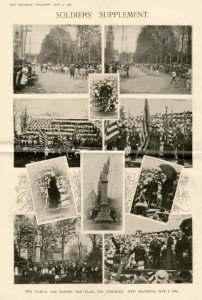 This monument stands at the apex of a triangular plot donated by the First Presbyterian Church at the intersection of Huguenot and Main Streets. It honors the 370 men from New Rochelle who joined the Union cause and was erected by the Soldiers Memorial Association which included members of the Flandreau Post, No. 509, Grand Army of the Republic. The cost was $2,500. The cornerstone was laid on May 30, 1895 and the monument was dedicated on May 9, 1896.The monument is 26 ft. high and depicts a 6-foot, full-length uniformed Civil War soldier bearing a flag on its pole in his proper left hand stands on a column atop a tiered base. He holds a sword in his proper right hand. The column has bas-reliefs and inscriptions on all four sides. The reliefs are separated by upward pointing cannon barrels and emblems honoring the Cavalry, Artillery and Navy, and also a United States insignia and the Coat of Arms for the City of New Rochelle. The Badger Brothers of West Quincy, Massachusetts were the fabricators
This monument stands at the apex of a triangular plot donated by the First Presbyterian Church at the intersection of Huguenot and Main Streets. It honors the 370 men from New Rochelle who joined the Union cause and was erected by the Soldiers Memorial Association which included members of the Flandreau Post, No. 509, Grand Army of the Republic. The cost was $2,500. The cornerstone was laid on May 30, 1895 and the monument was dedicated on May 9, 1896.The monument is 26 ft. high and depicts a 6-foot, full-length uniformed Civil War soldier bearing a flag on its pole in his proper left hand stands on a column atop a tiered base. He holds a sword in his proper right hand. The column has bas-reliefs and inscriptions on all four sides. The reliefs are separated by upward pointing cannon barrels and emblems honoring the Cavalry, Artillery and Navy, and also a United States insignia and the Coat of Arms for the City of New Rochelle. The Badger Brothers of West Quincy, Massachusetts were the fabricators
The principal speakers at the dedication on May 9, 1896 were General Daniel A. Butterfield and General Daniel E. Sickles. Both of these Union Army officers had impressive war records and were controversial figures thorough out their lives. Butterfield was born in Utica, NY and entered the Union Army with the rank of sergeant shortly after the Confederate attack on Ft. Sumter Service in April of 1861. Within weeks of joining he somehow obtained the rank of colonel heading up the 12th NY Volunteer Regiment. By July, he commanded a brigade and by September he was a brigadier general. In the Seven Days Battles, at Gaines’ Mill on June 27, 1862, he was wounded and after the war (in 1892) he was awarded the Medal of Honor for his actions at that battle. During his convalescence, Butterfield experimented with bugle calls and is credited with composing, “Taps”, probably the most famous bugle call ever written. However, some musical historians maintain that Butterfield merely revised an earlier bugle call and did not compose an original work.
Although he never attended U.S Military Academy at West Point, General Butterfield managed to construct an elaborate Egyptian pyramid-style tomb for himself there. Apparently, he had a fear of being buried alive and installed a coffin alarm in it. The story goes that a few days after he was buried, mischievous Cadets snuck in to the cemetery one night and pulled the alarm’s cord sending the caretaker rushing to the General’s rescue. This prank happened on several other occasions and the bell was silenced forever by the West Point authorities.
Sickles was a New York politician before the Civil War began and was involved in a number of public scandals, most notably the killing of his wife’s lover, Philip Barton Key II, son of Francis Scott Key. He was acquitted with the first use of temporary insanity as a legal defense in U.S. history. He became one of the most prominent politically appointed generals of the Civil War. At the Battle of Gettysburg, he insubordinately moved his III Corps to a position in which it was virtually destroyed, an action that continues to generate controversyto this day. His combat career ended at Gettysburg when his leg was struck by cannon fire. Sometime later he donated the preserved bones from his leg to the newly founded Army Medical Museum in Washington, D.C. in a small coffin-shaped box, along with a visiting card marked, “With the compliments of Major General D.E.S.”
Bust of a Civil War Soldier, Montrose, NY
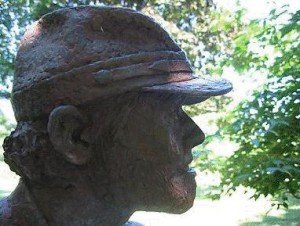 This bronze bust of a Civil War soldier is found at the Franklin D. Roosevelt Veterans Hospital in Montrose, NY and is just one of 10 other busts that stand on columns at The Sculpture Garden located there dedicated to the soldiers, sailors, marines and aviators that fought in America’s various wars. Interestingly enough, a second set of casts from the eleven original sculptures was made and are on display at the Westchester County Veterans Museum in Somers, N
This bronze bust of a Civil War soldier is found at the Franklin D. Roosevelt Veterans Hospital in Montrose, NY and is just one of 10 other busts that stand on columns at The Sculpture Garden located there dedicated to the soldiers, sailors, marines and aviators that fought in America’s various wars. Interestingly enough, a second set of casts from the eleven original sculptures was made and are on display at the Westchester County Veterans Museum in Somers, N
.Y.
Nils H. Andersen, a troubled World War II veteran who was a patient at this facility, sculpted all the busts. He was not physically injured in the war but returned home with what is now termed PTSD and as a result, fell victim to alcoholism and a number of related illnesses and became homeless. In 1986, at the age of 60, Nils Andersen found his way to the Montrose Veterans Administration Hospital. Apparently, he had some artistic talent, so his therapist, Ms. Florence Quillinan, encouraged him to take sculpting as part of his treatment, and he made eleven clay busts of members of the various armed services.
Andersen made several unsuccessful efforts to get the funds to have his sculptures cast in metal. Finally, help came from the estate of an 89-year-old veteran, Kathryn Poland, a World War I captain in the Army Nurse Corps who died at The FDR Veterans Hospital in 1983 without heirs and an estate of $36,700. It paid a portion of the cost of casting the sculptures. The first ten sculptures were cast in bronze in 1988 at Tallix, Inc., in Beacon, N.Y. Landscape architect Henry H. Liede, of Croton-on-Hudson, N.Y., generously volunteered to design the sculpture garden. It was dedicated on May 25, 1989, dubbed “Nils Andersen Day.” Andersen, Marine Corps brass, hospital officials and hundreds of veterans were present.
Nils Andersen died on August 2, 1993, in the Bronx (N.Y.) Veterans Affairs Medical Center. He was 67 and is buried in Calverton National Cemetery on Long Island. His studio was at 20 Everett Avenue in Ossining, NY where he created other sculptures. A bust of Gen. William Booth, founder of the Salvation Army, is displayed in a New York City Salvation Army shelter where Andersen once lived. The Montrose hospital also has three Andersen statues of homeless men in storage. These await some benefactor who will underwrite the cost of casting them in metal.
Civil War Obelisk, Village of Somers, NY
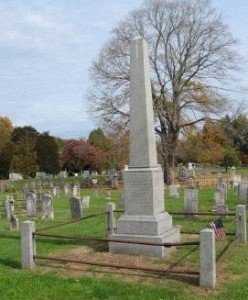 This 15ft. granite obelisk commemorates the men from of Somers and North Salem who served or fell in the Civil War. It stands at Ivandell Cemetery on on Somerstown Turnpike (U.S. 202) Route about ? mile north of Somers Town Hall (AKA The Elephant Hotel). Part of the inscriptions read as follows: “In Memoriam Of The Brave Men From This Vicinity Who Fell In The Great Rebellion. Erected By The Ladies Soldiers And Society Of Somers 1865.”
This 15ft. granite obelisk commemorates the men from of Somers and North Salem who served or fell in the Civil War. It stands at Ivandell Cemetery on on Somerstown Turnpike (U.S. 202) Route about ? mile north of Somers Town Hall (AKA The Elephant Hotel). Part of the inscriptions read as follows: “In Memoriam Of The Brave Men From This Vicinity Who Fell In The Great Rebellion. Erected By The Ladies Soldiers And Society Of Somers 1865.”
For some unexplained reason seven soldiers from Salem and North Salem were not inscribed on the monument. They are Ezra Griffen -38th N.Y. Volunteers- Charles Gray-6th N.Y. Heavy Artillery- Charles Bailey, John W. Knapp, James Russel and Warren Spenseer-4th N.Y. Heavy Artillery.
Standing Soldier Monument, Mount Vernon. NY
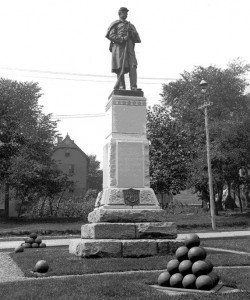 Mount Vernon’s eight foot bronze Standing Soldier statute stands in the “parade rest” at position Farnsworth Park on a triangular piece of ground in front of what is now Mount Vernon Hospital. The tablet on the front of the 10ft. granite pedestal reads “Erected by the Citizens of Mount Vernon to her loyal sons who fought for the Union.” The tablet in the back or west side has another inscription that says “To the noble women who, from home, hospital and field contributed to the preservation of the Union.” In this regard, it is the only Civil War monument in Westchester County and perhaps the State of New York that recognizes the invaluable role of women in that conflict. However, this tablet was not in existence at the time the monument was dedicated in June of 1890 and there is no record of when it was placed there and by whom.
Mount Vernon’s eight foot bronze Standing Soldier statute stands in the “parade rest” at position Farnsworth Park on a triangular piece of ground in front of what is now Mount Vernon Hospital. The tablet on the front of the 10ft. granite pedestal reads “Erected by the Citizens of Mount Vernon to her loyal sons who fought for the Union.” The tablet in the back or west side has another inscription that says “To the noble women who, from home, hospital and field contributed to the preservation of the Union.” In this regard, it is the only Civil War monument in Westchester County and perhaps the State of New York that recognizes the invaluable role of women in that conflict. However, this tablet was not in existence at the time the monument was dedicated in June of 1890 and there is no record of when it was placed there and by whom.
In any event, the monument came to be there largely through the efforts of Colonel Henry Huss a Bavarian immigrant who served in the battles of Chancellorsville, Fredericksburg and the Florida campaign. Following the War he was President of the City Board of Trade and deeded the plot that that accommodates the monument. Almost $2,000 was raised for the construction costs and on May 30, 1891, the statute was unveiled. Supposedly, a copper box is buried beneath the granite base that contains personal memoranda of the monument committee members, including a list of contributors several Civil War artifacts and a history of the New York Industrial Home Association No.1, the group that led the drive to incorporate the Village of Mount Vernon in the 1850s.
Standing Soldier Monument, Rye, NY
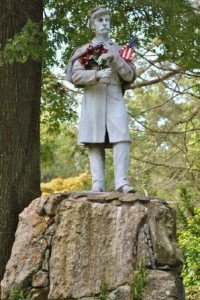 This is the Civil War monument at Greenwood-Union Cemetery, in Rye dedicated with much fanfare in 1888. The soldier is in the typical- parade rest position but the rifle he once clutched is missing. George Beck was the sculptor and the statute was cast by the Abendroth Brothers Foundry in Port Chester, NY. 10 years later, a plaque was added commemorating Newell Rising, a young sailor from Port Chester killed on the “Maine” in Havana Harbor during the Spanish-American War.
This is the Civil War monument at Greenwood-Union Cemetery, in Rye dedicated with much fanfare in 1888. The soldier is in the typical- parade rest position but the rifle he once clutched is missing. George Beck was the sculptor and the statute was cast by the Abendroth Brothers Foundry in Port Chester, NY. 10 years later, a plaque was added commemorating Newell Rising, a young sailor from Port Chester killed on the “Maine” in Havana Harbor during the Spanish-American War.
The Yonkers Soldiers and Sailors Monument
Standing the east grounds of the Manor Hall in Yonkers is the Soldiers and Sailors Monument erected under the auspices the Soldiers and Sailors Monument Association. The monument cost approximately $13,000 to build Standing the east grounds of the Manor Hall in Yonkers is the Soldiers and Sailors Monument erected under the auspices the Soldiers and Sailors Monument Association. The monument cost approximately $13,000 to build and the money was raise by subscriptions from local individuals and organizations.
Its granite shaft is 9 ft. square at the base and the overall height of the monument is 46ft. high. On May 30, 1888, at a Memorial Day service, William Allen Butler, a Yonkers lawyer and poet, suggested a monument to remember the Yonkers soldiers who had fought to preserve the union during the Civil War. His vision was realized three years later, on September 17 1891 when the Soldiers’ and Sailors’ Monument was dedicated on the grounds of Philipse Manor Hall
The statuary consists of five pieces, representing the Infantry, Artillery, Cavalry, and Navy and there is an 8 Ft figure of a Flag-Bearer on top. Each one was from entirely new and original designs. The figure of the sailor and was designed by Lt. Washington Irving Chambers of the USS Petrel and the remaining three statues were designed by James Edward Kelly of New York City. Each of four bronze lower statues are 7 ft. feet high and were sculpted by Mr. Lorado Taft and cast by the American Brass Company of Chicago.
As was typical of monument unveilings there were several speeches by local politicians, appointed officials, other dignitaries and prominent military veterans. The New York Times of September 18, 1891 reported that an estimated 20,000 people attended the ceremony and the parade which includes several bands and units of the National Guard and of the Grand Army of the Republic. The article concluded with an account of the evening’s celebratory events:
“At night, there was a beautiful illuminated parade of yachts on the river. There were about 60 boats of the Corinthian Club towed in three divisions by steam launches. They were all decorated from stem to sterm with colored lanterns and were setting of Greek fire and rockets with a profusion that
was bewildering. The enchantment of the scene was added to by the big electric flash light of the [USS] Boston which kept playing in and out among the illuminated yachts, After the boat parade there was a hop at the yacht club house.”
The upper statue of the Color-Bearer measures eight feet to the head, and eleven feet to top of the flagpole. He stands with cannon and balls at his feet and is in the act of drawing his sword to defend the flag. It was sculptured from Ryegate, Vermont granite. The Infantry Statue is on the east facade of the monument and the soldier demonstrates the “fix bayonets” position. The inscriptions immediately below him read as follows: “PATRIOTISM TO HONOR THE MEN OF YONKERS WHO FOUGHT TO SAVE THE UNION. SLAVERY ABOLISHED.”
This dismounted cavalryman stands on the south facade of the monument. Below him are the following inscriptions: “VALOR MY PARAMOUNT OBJECT IS TO SAVE THE UNION. -LINCOLN” and “LET US HAVE PEACE -GRANT”
This sailor stands on the west facade of the monument with his sword ready to engage the enemy in hand-to-hand combat. The inscriptions below the sailor reads: “COURAGE THE UNION MUST AND SHALL BE PRESERVED. -JACKSON.” and “THE UNION SAVED.” This statue of an artilleryman stands on the north facade of the monument and has the following inscriptions below him: “ENDURANCE THE UNION IS THE PALLADIUM OF OUR SAFETY AND PROSPERITY – WASHINGTON” and “CREDIT MAINTAINED”
Town of Cortlandt Civil War Monument
This monument is actually located in the City of Peekskill, near the intersection of Main Steer (Rt. 6) and North Division Street and consists of a Civil War color bearer standing atop a 40 ft tall tapered polished granite shaft on a tiered base. The figure wears a long coat and cap. He holds the flag pole in his left hand. Three additional uniformed figures, a sailor, a cavalryman and an artilleryman stand at the base of the shaft. On the South side of the Monument the Inscription reads, “To The Memory Of The Soldiers and Sailors From The Town of Cortlandt Who Served in the Civil War 1861 – 1865.” A bronze plaque on the North Side says, “Erected by The Citizens of The Town of Cortlandt Through the Efforts of the Veterans Monument Association And All Organizations Affiliated With The Grand Army Of The Republic.” Inscribed on the column are the names of various battles that Cortlandt men fought in – “Fort Fisher • Cold Harbor • Wilderness • Appomattox • Cedar Creek • Vicksburg • Gettysburg • Antietam.”
The monument was commissioned Jan. 1916 and dedicated on Sept. 4, 1916 with a speech by Lt. General George B. Loud. He served as a Lieutenant during the War with Company D, 10th U.S. Colored Troops Heavy Artillery. The monument’s granite material came from the Jones Brothers Quarry in Barre, Vermont. It was once “the largest granite manufacturing plant in the world,” and had over 600 employees and occupied 100,000 square feet of operational space until it closed in 1975.